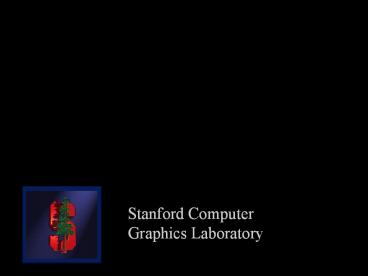High-performance imaging using dense arrays of cameras - PowerPoint PPT Presentation
Title:
High-performance imaging using dense arrays of cameras
Description:
yields perspective flyarounds and focal stacks from a single ... Canon 20D digital camera. ordinary microscope. light field microscope. 200 . 2006 Marc Levoy ... – PowerPoint PPT presentation
Number of Views:102
Avg rating:3.0/5.0
Title: High-performance imaging using dense arrays of cameras
1
Light field microscopy
Marc Levoy, Ren Ng, Andrew Adams Matthew
Footer, Mark Horowitz
Stanford Computer Graphics Laboratory
2
Executive summary
- captures the 4D light field inside a microscope
- yields perspective flyarounds and focal stacks
from a single snapshot, but at lower spatial
resolution - focal stack ? deconvolution microscopy ? volume
data
3
Devices for recording light fields
(using geometrical optics)
- handheld camera Buehler 2001
- camera gantry Stanford 2002
- array of cameras Wilburn 2005
- plenoptic camera Ng 2005
- light field microscope (this paper)
4
Light fields at micron scales
- wave optics must be considered
- diffraction limits the spatial angular
resolution - most objects are no longer opaque
- each pixel is a line integral through the object
- of attenuation
- or emission
- can reconstruct 3D structure from these integrals
- tomography
- 3D deconvolution
5
Conventional versus plenoptic camera
6
Conventional versus plenoptic camera
7
8
Digital refocusing
S
- refocusing summing windows extracted from
several microlenses
9
Example of digital refocusing
10
Refocusing portraits
11
Macrophotography
12
Digitally moving the observer
S
S
- moving the observer moving the window we
extract from the microlenses
13
Example of moving the observer
14
Moving backward and forward
15
A light field microscope (LFM)
eyepiece
intermediate image plane
objective
specimen
16
A light field microscope (LFM)
- 40x / 0.95NA objective
- ?
- 0.26µ spot on specimen 40x 10.4µ on sensor
- ?
- 2400 spots over 25mm field
- 1252-micron microlenses
- ?
- 200 200 microlenses with12 12 spots per
microlens
sensor
eyepiece
intermediate image plane
objective
specimen
? reduced lateral resolution on specimen
0.26µ 12 spots 3.1µ
17
A light field microscope (LFM)
sensor
18
Example light field micrograph
- orange fluorescent crayon
- mercury-arc source blue dichroic filter
- 16x / 0.5NA (dry) objective
- f/20 microlens array
- 65mm f/2.8 macro lens at 11
- Canon 20D digital camera
200µ
ordinary microscope
light field microscope
19
The geometry of the light fieldin a microscope
- microscopes make orthographic views
- translating the stage in X or Y provides no
parallax on the specimen - out-of-plane features dont shift position when
they come into focus
objective lenses are telecentric
20
Panning and focusing
panning sequence
focal stack
21
Mouse embryo lung(16x / 0.5NA water immersion)
200µ
pan
focal stack
light field
22
Axial resolution(a.k.a. depth of field)
- wave term geometrical optics term
- ordinary microscope (16x/0.4NA (dry), e 0)
- with microlens array (e 125µ)
- stopped down to one pixel per microlens
? number of slices in focal stack 12
23
3D reconstruction
- confocal scanning Minsky 1957
- shape-from-focus Nayar 1990
- deconvolution microscopy Agard 1984
- 4D light field ? digital refocusing ?3D focal
stack ? deconvolution microscopy ?3D volume
data
24
3D deconvolution
McNally 1999
focus stack of a point in 3-space is the 3D PSF
of that imaging system
- object PSF ? focus stack
- ? object ? PSF ? ? focus stack
- ? focus stack ? ? PSF ? ? object
- spectrum contains zeros, due to missing rays
- imaging noise is amplified by division by zeros
- reduce by regularization, e.g. smoothing
25
Silkworm mouth(40x / 1.3NA oil immersion)
100µ
slice of focal stack
slice of volume
volume rendering
26
Insect legs(16x / 0.4NA dry)
200µ
27
3D reconstruction (revisited)
- 4D light field ? digital refocusing ?3D focal
stack ? deconvolution microscopy ?3D volume
data - 4D light field ? tomographic reconstruction
?3D volume data
28
Implications of this equivalence
- light fields of minimally scattering volumes
contain only 3D worth of information, not 4D - the extra dimension serves to reduce noise, but
could be re-purposed?
29
Conclusions
- captures 3D structure of microscopic objects in a
single snapshot, and at a single instant in time
Calcium fluorescent imaging of zebrafish larvae
optic tectum during changing visual stimula
30
Conclusions
- captures 3D structure of microscopic objects in a
single snapshot, and at a single instant in time - but...
- sacrifices spatial resolution to obtain control
over viewpoint and focus - 3D reconstruction fails if specimen is too thick
or too opaque
31
Future work
- extending the field of view by correcting
digitally for objective aberrations
32
Future work
- extending the field of view by correcting
digitally for objective aberrations - microlenses in the illumination path
- ? an imaging microscope scatterometer
angular dependence of reflection from single
squid iridophore
33
http//graphics.stanford.edu/projects/lfmicroscope































